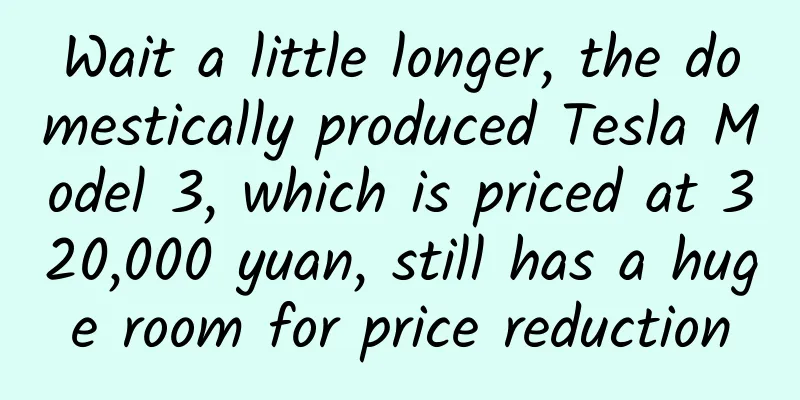Wait a little longer, the domestically produced Tesla Model 3, which is priced at 320,000 yuan, still has a huge room for price reduction

|
Finally, Tesla announced the price of the Model 3 made in China: starting from RMB 328,000. Tesla fans who were waiting to buy the car were speechless and their disappointment was beyond words, while those who worked in the Internet car manufacturing industry also breathed a sigh of relief after experiencing the violent fluctuations in the stock price. Because as Li Xiang, president of CHJ Automotive, once said, "According to the current exchange rate, the domestically produced Model 3 will definitely be sold directly at a starting price of 250,000 to 270,000 yuan (price before subsidies)." And the current price undoubtedly adds some "IQ tax" out of thin air. Although the starting price of the domestically produced Model 3 is set at RMB 300,000, unfortunately, this is only the most basic price and does not include the biggest soul of Tesla electric vehicles - AP (Autopilot, a driving assistance function suite) and FSD (Full Self-Driving, fully automatic driving), and even the cruising range is only 460 km. In order to intuitively show the price of the domestically produced Model 3, we can take a look at the price comparison between the domestically produced Model 3 and the imported Model 3. The domestic Tesla Model 3 Standard Range Upgrade Edition has a range of 460 km. If AP+FSD is purchased separately, the final price is RMB 411,800. The imported Tesla Model 3 rear-wheel drive long-range version (with built-in AP, official FSD), with a range of 600+Km, has a final selling price of RMB 421,000. Although the latter is slightly more expensive than the former by 10,000 yuan, the imported Model 3 also has an additional 160km of range. Overall, the tariffs and manufacturing costs saved by the localization of the Model 3 have not been passed on to consumers. It can even be responsibly said that not only is there no discount at all, but the price competitiveness is far less than that of imported products. With such weird localization, what exactly do Musk and his Tesla want to do? Tesla's strange pricing strategy According to Tesla, the domestically produced Model 3 will be available for pre-order on May 31, 2019, and the estimated delivery time is 6 to 10 months. In other words, if we order a domestically produced Model 3 in mid-2019, in the best case scenario, we will have to wait until the end of 2019 or the beginning of 2020 to pick up the car. Once Tesla sets the price of the domestically produced Model 3 too low (compared to the imported Model 3), it will cause a phenomenon - consumers in China will all buy the domestically produced Model 3, which is definitely not good news for Tesla. On the one hand, Tesla's sales in the Chinese market will plummet in the third and fourth quarters; on the other hand, since the factory has just been built, Tesla's factory in China cannot handle the large number of domestic Model 3 orders. Perhaps Tesla deliberately made the price of the domestically produced Model 3 equal to that of the imported Model 3. This way, the company's performance will not be affected and the new factory will have a chance to breathe. I believe that after the domestically produced Model 3 starts to be delivered, Tesla will steadily lower the price of the domestically produced Model 3. No one can be sure whether it can reach the price range of 250,000 to 270,000 yuan in one step, but there is still great hope that it can be reduced to less than 300,000 yuan. After all, behind Tesla, there are a group of traditional Chinese car manufacturers and hungry Internet car manufacturers, and they are all eyeing Tesla's every move. High-priced Tesla is still a nightmare for domestic brands At the same time as the price of the domestically produced Model 3 was announced, He Xiaopeng, chairman of Xpeng Motors, commented: "The domestically produced Model 3 is priced at 328,000 yuan (without autonomous driving) and is not competitive at all. The price should be reduced by at least $10,000." He Xiaopeng believes that things are different now. Tesla's previous advantages in batteries and electronic controls have been equalized by domestic brands. If Tesla still keeps the same price after receiving so many policies and subsidies, it is either because of cost control problems or because it wants to get the profit margin of five years ago (IQ tax). Unlike other markets around the world, electric vehicles started very early in China. China began to encourage the development of the electric vehicle industry ten years ago. In 2018, the sales of pure electric passenger vehicles reached 788,000. Interestingly, in the sales list of pure electric vehicles in China, none of the top ten is a high-end brand. This is very similar to the wild days when mobile Internet was just emerging ten years ago. Most of the market sales were taken away by low-priced phones, and many emerging domestic smartphone manufacturers and Apple were still trying to make users accept their brands and "enter the homes of ordinary people." From this perspective, Model 3 is a bit like the iPhone back then - an industry leader, subverting traditions, possessing core competitiveness, and having a large number of die-hard fans. However, just like the essence of Apple mobile phones is its chips and systems, these have been maintained in the domestic market, and it is normal for the market to give huge returns. On the other hand, Tesla has abolished its own martial arts and cancelled the AP and FSD that domestic electric car manufacturers are most afraid of. This is like Ouyang Feng coming to the Central Plains martial arts world, but voluntarily stated that he would not use the Toad Kung Fu. Despite this, Tesla, which has lost half of its power, still has terrifying combat power, especially for our domestic brands. Does He Xiaopeng's evaluation of Tesla make sense? Yes! But we can only listen to half of it, because he also said, "Wait until 2020." The time buffer period is fair to everyone, including domestic Tesla and domestic brands. To be fair, Tesla's lead in battery technology is still difficult to shake. Take the new 21700 power battery used in Model 3 as an example. It is larger than the original 18650 battery and has an energy density of about 300Wh/kg, while the highest-level NCM811 battery in China has a single cell energy density of only 180Wh/kg. In other words, the energy density of Tesla's 21700 power battery is 1.6 times higher than that of domestic batteries. Due to the limitations of battery energy density, in order to ensure battery life, domestic brands often have no choice but to adopt another strategy, which is to increase the number of batteries, which in turn brings about the problem of increased car weight. In addition to the excellent battery quality, Model 3 also maintains a certain lead in motor technology. Two high-power permanent magnet synchronous motors with a total power of more than 340KW, and the power of the rear axle motor reaches 210KW. BYD is the best in the domestic permanent magnet synchronous motor power. The maximum output power of the motor equipped in the latest BYD Tang EV is only 180KW. Looking at the domestic electric car companies, what can we say? While listening to their bold words, we might as well give them a little more time, that's it. Crisis and opportunity coexist Due to various reasons, the Chinese government has been vigorously subsidizing the domestic new energy vehicle industry, which has also made the product strategy of most electric vehicle manufacturers always oriented towards obtaining "subsidies". But things started to change in March this year. Compared with 2018, both national and local subsidies have shrunk significantly. For example, in 2018, the national government provided 50,000 yuan in subsidies for vehicles with a range of more than 400 km, and local governments provided 0-25,000 yuan in subsidies; in 2019, only vehicles with a range of more than 400 km will receive a national subsidy of 25,000 yuan. The fact that subsidies will be reduced is a foregone conclusion. It is foreseeable that with the gradual reduction of subsidies and the localization of Tesla, domestic electric vehicle manufacturers will bid farewell to the previous "greenhouse" and join the brutal consumer-oriented competition. Although the domestically produced Tesla Model 3 may very well become a nightmare for domestic electric vehicle manufacturers in the future, on the other hand, who can deny that this is also an opportunity for domestic electric vehicles? Before the localization of Model 3, most domestic electric vehicle manufacturers started at the same level, so there was not much difference in the final products - it was just the price that determined the ceiling height that each could reach. As Model 3 enters the domestic market and competes directly with domestic electric vehicle manufacturers, on the one hand, it allows domestic electric vehicle manufacturers to recognize the development trend of the industry and the needs of consumers, and on the other hand, it takes the initiative to read the spell of tightening the reins for themselves. In this sense, Tesla is the big catfish that stirs up the pond and activates the half-asleep domestic electric vehicle brands. In addition, after Tesla enters China, its massive factory construction plan will also drive a number of local supply chain companies, giving domestic electric vehicle manufacturers the opportunity to reap the benefits and further narrow the gap with Tesla. Therefore, we assert that after the domestic Model 3 further reduces its price in the first quarter of next year, the entire electric vehicle industry will usher in a major reshuffle. Only car companies with core technological capabilities will be able to survive better, and companies that simply rely on subsidies, big promises, and PPT sales will be eliminated by the market in the first place. For the Chinese electric vehicle market, this is Tesla's greatest contribution. As a winner of Toutiao's Qingyun Plan and Baijiahao's Bai+ Plan, the 2019 Baidu Digital Author of the Year, the Baijiahao's Most Popular Author in the Technology Field, the 2019 Sogou Technology and Culture Author, and the 2021 Baijiahao Quarterly Influential Creator, he has won many awards, including the 2013 Sohu Best Industry Media Person, the 2015 China New Media Entrepreneurship Competition Beijing Third Place, the 2015 Guangmang Experience Award, the 2015 China New Media Entrepreneurship Competition Finals Third Place, and the 2018 Baidu Dynamic Annual Powerful Celebrity. |
<<: What is the future of e-sports anchors after gaining fame and fortune?
>>: With its share price falling by 70%, does NIO, which keeps self-igniting, still have a future?
Recommend
How to read and write Word doc/docx and PDF files in Android?
Recently, I need to generate Word doc and docx fi...
2020 Hunan College Entrance Examination Score Line Announced 2020 Hunan College Entrance Examination Score Line
2020 Hunan College Entrance Examination Score Lin...
What is the difference between WeChat ID and WeChat account? I finally figured it out today
[[335883]] Not long ago, WeChat finally supported...
Complete guide to Tik Tok operations and the law of attraction!
This article explains the operation of TikTok fro...
Mobile game design: effectively distinguish and implement iterative design and planned design
[[131190]] Mobile game design usually follows two...
There are also auroras on Mercury, but they haven’t emitted light yet!
Produced by: Science Popularization China Author:...
APP promotion丨Analysis of the advantages and disadvantages of mainstream promotion channels
01 Classification by traffic rating The editor di...
Ping An Health Product Analysis
At present, there are more than 3,000 certified m...
Electric Technology Car News: Highlander has long been unable to satisfy the thirsty car buyers. Who will be the next SUV overlord among Trumpchi, Changan and Haval?
With the rapid rise of domestic auto brands, more...
Why do some people feel “bad mentally” during mental health week?
In today's society, mental and psychological ...
Xue Song Behavioral Finance, Vol. 1
Xue Song's Behavioral Finance, Issue 1 Resour...
How much is the price for being an agent of Jiamusi catering kitchen app? Jiamusi Kitchen Mini Program Agent Price Inquiry
Is it easy to be an agent of Jiamusi Restaurant K...
"Intelligent Connected Vehicle Technology Roadmap 2.0" released! Juefei Technology takes the lead in realizing the large-scale implementation of the vehicle-road-cloud industry
Recently, the "2020 World Intelligent Connec...
[Original] Free promotion of APP with zero budget in the early stage, just do these 17 points!
Preface: I have been working for several years. I...
Zibo SEO training: Baidu algorithm adjustment keyword ranking drop may be due to these reasons
Every time Baidu adjusts its algorithm, it will a...









